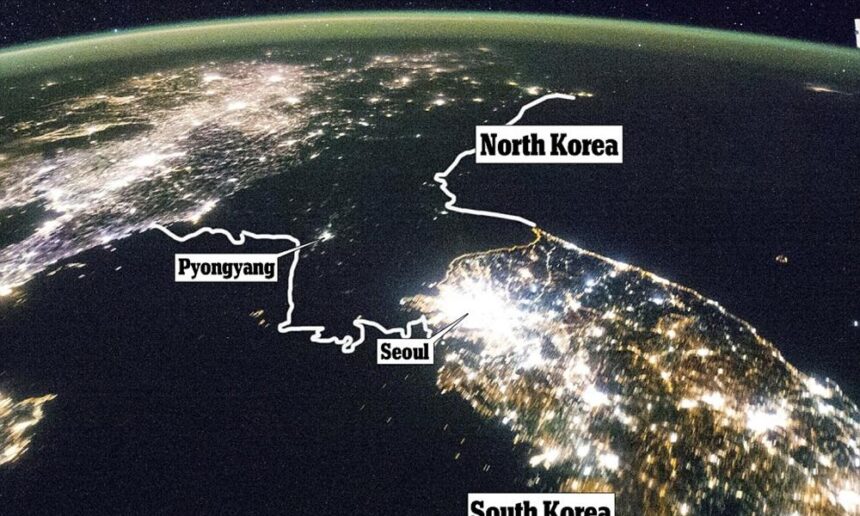After World War II, most nations in the world were divided into two camps: capitalist and socialist. So was Korea. The war between South Korea and North Korea started in 1950, and casualties reached five million within three years.Under the armistice agreed upon between the United Nations, North Korea, and China, the Korean Peninsula was declared a demilitarized zone at the 38th parallel, creating the four-kilometer wide and 250-kilometer long DMZ.
Today it is a place under the threat of a war that could break out on a large scale at anytime. More than 25,000 troops from the United States Armed Forces are located in South Korea and do military training in cooperation with 300,000 South Korean troops every year.
For 60 years, since the divide, South Korea has stayed on the path of capitalism and developed following the example of the United States. South Korea has 50 million people living on 100,000 square kilometers. North Korea followed socialism and developed under the influence of the Soviet Union and China. North Korea has a population of 25 million and a territory of 120,000 square kilometers. South Korea’s economy today is 40 times larger than North Korea’s, and their GDP per capita is almost 20 times greater than GDP per capita in North Korea.
A new NASA satellite image of the Korean Peninsula has recently been published. North Korea had very few lights, and Pyongyang was the only city that looked bright. It was a completely different picture for South Korea. The entire country was lit up, with every city looking bright. The same observation can be made of the economy, the freedom of their people, and living standards in these countries.
When will the Korean Peninsula develop as one and see family members reunited? When will the two Koreas unify, and what will it cost? Who wants them unified?
SHORT-LIVED POLICIES
In 1998, South Korean President Kim Dae Jung articulated and implemented a foreign policy referred to as the Sunshine Policy, designated to “light the North Korean night like it was day”. The policy resulted in more active relations between the two Koreas, emphasized by summit meetings held in Pyongyang, business deals taking place, and allowing family reunions for people who had been separated. President Kim Dae Jung was awarded the Nobel Peace Prize in 2000 for his contributions to peace and security on the Korean Peninsula.
The next South Korean President, Roh Moo-hyun, attempted to sustain the policy during his presidency (2003-2008). However, he received criticism from domestic audiences who argued that South Korea was providing economic aid to the North Korean dictatorship without any conditions or requests. As the criticism grew, allegations were made that President Roh was continuing the policy only to gain political support and win the elections.
This coincided with increased international criticism of North Korea for developing a nuclear weapons system breaching international laws. President Lee Myung-bak (2008-2013) toughened relations with North Korea and started setting certain conditions. This was followed by accusations of a North Korean torpedo sinking a South Korean Navy ship in 2010, claiming 40 lives. North Korea claimed that they were not responsible for the incident. Seven months later, the two Koreas exchanged artillery fire on a disputed island.
In 2013, South Korea elected its first female president. President Park Geun-hye, daughter of President Park Chung-hee (1963-1979). She was the first president to present the “daebak” theory in 2014, saying that the unification of the two Koreas would bring massive benefits not only to the Koreas but the entire region.
In January 2015, President Park said that she was willing to meet with North Korean leader Kim Jong-un without setting any conditions. South Korea provided 25 billion USD in humanitarian aid to North Korea through international organizations in 2015.
North Korea conducted a nuclear weapons test on January 6, 2016, and launched a rocket on February 7, attempting to prove that its weapons can reach any target. A month later, the United Nations adopted Resolution 2270, imposing tougher economic sanctions on North Korea. It even shut down the Kaesong Industrial Park, which had been operating effectively. The two Koreas have not had any kind of discussions or negotiations for several months now.
REALITY
South Korea managed to complete making the leap from an underdeveloped country to a developed country very rapidly. Before the new millennia, South Korea’s younger generation had hoped that the two Koreas would unite and become a stronger nation together, whereas the elder generation were cautious about the notion. However, the younger generation in the 21st century does not hope for the same after seeing how the German reunification took place and what it cost. They now believe that the two Koreas have already become different nations.
The South Korean Ministry of Strategy and Finance estimated in 2013 that if the two Koreas unite, their expenditure will equal seven percent of the GDP for 10 years, and would increase by 80 billion USD every year. The Wall Street Journal speculated that building new infrastructure and increasing per capita income in a reunited Korea would take 30 years and put enormous pressure on the public budget with a cost of two to five trillion USD.
The development gap between East Germany and West Germany was not as large as the divide between South Korea and North Korea, yet ten years of investment after reunification cost 1.9 trillion USD. A 2009 Goldman Sachs report suggests that, despite the high costs of unification, Korea – as a single, unified nation – would become the eighth biggest economy in the world by 2050, leaving Germany and Japan behind. North Korea has considerably more natural resources compared to South Korea and is rich in rare minerals. It is said that their deposits would double global reserves when tapped into.
If that is true, it would be a jackpot win. However, the current reality suggests that it will be a long time before the two Koreas unify. Since the South Korean presidential election (which takes place every five years) is coming in 2017, it looks like Pak the Second of South Korea will not be able to meet with Kim the Third of North Korea.
The South Korean government’s policy is increasingly perceived as short-lived and seeking benefits within five-year terms. The public and scholars are encouraging the government to develop more far-sighted, longer term policies. The authorities of South Korea today are threatening North Korean leadership with their power, imposing sanctions with other countries.
Regardless of whether or not a nation is a dictatorship or a democracy, it is the people who should choose how they live. It is only a matter of time. Therefore, it is time for the world to pay more attention to providing accurate and timely information to the people of North Korea about themselves and other nations. North Korea currently has three million people using smart phones, which is an opportunity that can be taken advantage of.
The people of North Korea do not always receive full information about South Korea’s marvelous development. We have been seeing increasingly more information about North Koreans who have fled to South Korea (approximately 130,000 in total). Not everyone who comes to South Korea is able to adapt to the capitalist system and find a job without being discriminated against. It sometimes results in their return to North Korea, which does not help to advance the reunification of the two Koreas. A scholar from Sogang University says that the results of an anonymous survey done in North Korea suggest that more North Koreans wish to unify with China rather than South Korea.
It will be a long time before the two Koreas unify. If they ever unite, brothers and sisters who have completely different understandings and values will be required to have a lot of patience, work hard, and be forgiving and graceful. How much thought is being put into this by South Korean leaders?
Jeju-Seoul-Ulaanbaatar, 2016.06.01
Trans. by B.AMAR












